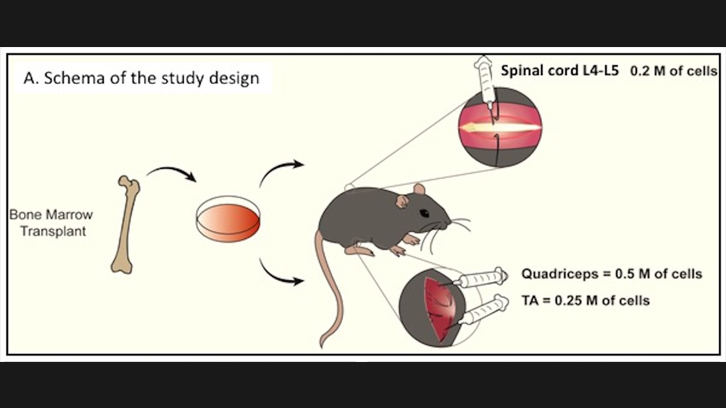Multiple strategy with bone marrow cells to treat ALS

There is no effective treatment to overcome Amyotrophic Lateral Sclerosis (ALS); nevertheless; the Neuroplasticity and Regeneration group of the UAB Institute of Neurosciences has tested two cell therapy protocols with ALS model mice to study, based on a multifocal strategy, how to protect motor neurons in the spinal cord and their connections with muscles, both of them targets of the disease.
Amyotrophic Lateral Sclerosis (ALS) is a neurodegenerative disease characterized by a progressive and selective death of upper (in the brain) and lower (in the spinal cord) motoneurons. Resulting from neuronal loss, patients suffer progressive atrophy and eventual muscle paralysis that leads to their death few years after the onset, since there is no effective treatment for ameliorating the disease. Most of the cases of ALS are sporadic, of unknown cause.
The concurrence of alterations in several molecular and cellular mechanisms raises the difficulty to find an effective treatment. In fact, therapies that only target a single factor have largely failed when translated into clinical trials in human patients. In this way, cell therapy has emerged as a promising way to target several disease-related mechanisms involved in ALS.
In this study, we assayed two different cell therapy protocols to protect both peripheral and central nervous system. For this purpose, we combined injections of bone marrow cells in several muscles of the hindlimbs of a mouse model of ALS to protect the connection of motor axons with the muscle, and an injection of bone marrow cells in the lumbar spinal cord of the same mice in order to protect the spinal motoneurons.
Cross section of the lumbar spinal cord, stained with cresyl violet, from a treated mouse (B) and from an untreated mouse (C). A higher number of motoneurons in the anterior horn (in the region marked with a circle) can be seen in the treated mouse than in the control.
The mice were repeatedly evaluated along two months after the cell therapy. The results found indicated that this strategy significantly improved the motor outcomes, measured in rotarod test and in electrophysiological tests. Moreover, we also found that the dual cell therapy tended to preserve the survival of spinal motoneurons at late stages of the disease and reduced the neuroinflammatory reaction in the spinal cord, although did not prolong mice survival.
Overall, our findings suggest that targeting more than one affected area of the motor system with bone marrow cell therapy may result in a valuable therapeutic intervention for ALS.
Department of Cell Biology, Physiology and Immunology.
Institute of Neurosciences.
Faculty of Medicine.
Universitat Autònoma de Barcelona (UAB).
References
Martínez-Muriana A, Pastor D, Mancuso R, Rando A, Osta R, Martínez S, López-Vales R, Navarro X. Combined intramuscular and intraspinal transplant of bone marrow cells improves neuromuscular function in the SOD1(G93A) mice. Stem Cell Res Ther 2020; 11(1):53. doi: 10.1186/s13287-020-1573-6.

